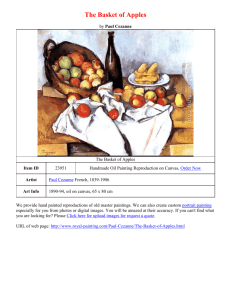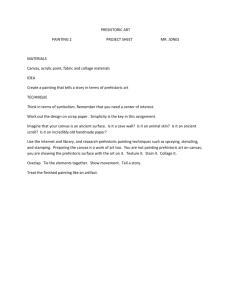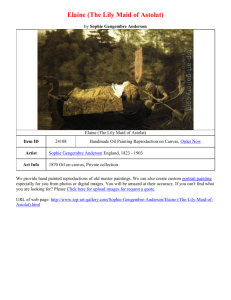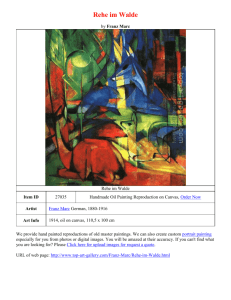Contemporary painting in Germany
advertisement
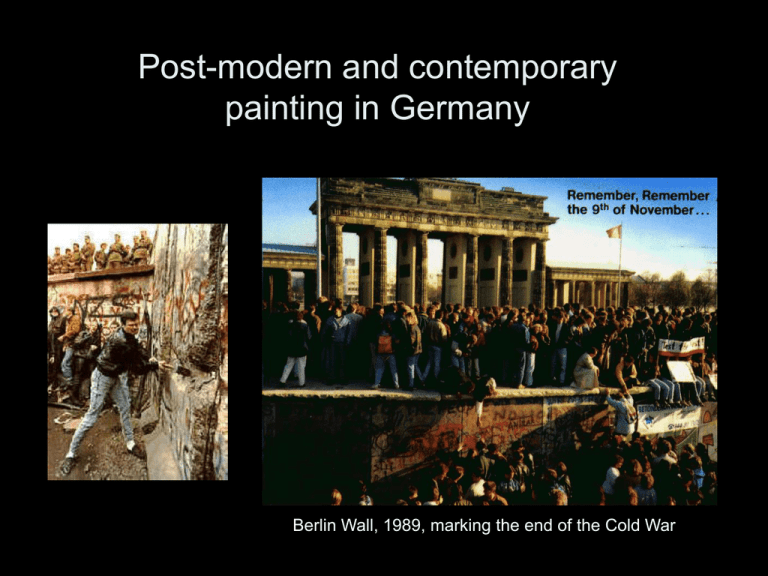
Post-modern and contemporary painting in Germany Berlin Wall, 1989, marking the end of the Cold War Annihilation of Modern Art in Nazi Germany 1933- 45 (left) Ernst Ludwig Kirchner (German Expressionist,1880-1938) Girl Under a Japanese Umbrella, 1906; (right) Emil Nolde (German Expressionist, 1867-1956), Excited People, 1910; (below) Degenerate Art Exhibition, Munich, 1937 Composition with Blue, 1926 Piet Mondrian, oil, 24 in. sq. “Degenerate Art” The poster of the Degenerate Music exhibition (1938). Jewish Composers and Jazz/Swing musicians were, for instance, accused by the Nazis of producing "degenerated music"... Marc Chagall, Purim, 191618, oil, 20 x 28 in, exhibited in Nazi Degenerate Art Exhibition “Good German Art” – Socialist Realism (only) Joseph Beuys (German, 1921-1986), (left) Fat Chair, 1964 (right) Felt Suit, 1970; (center) Joseph Beuys the artist: "The whole process of living is my creative act." First German artist after WW II to achieve international fame based on exploration of his German identity Joseph Beuys, How to Explain Paintings to a Dead Hare, performance on Nov. 26, 1965. Three hours talking about pictures in in the Galerie Schmela in Düsseldorf. The hare was one of Beuys’ totemic animals. Artist’s face was coated with honey and gold leaf and one of his shoes had an iron heel: symbolic materials. Artist shaman Joseph Beuys, The Pack (2 views), 1969. Volkswagen bus with twenty-four wooden sleds, each with felt, flashlight, fat and stamped with brown oil paint The Dionysian versus the Apollonian Joseph Beuys, I Like America and America Likes Me, performance, “Action,” René Block Gallery, NYC, May, 1974 Beuys, Honey Pump at the Workplace for Documenta, 1977, electric motors pumped honey through a gigantic assemblage of pipes in the stairwell of the museum, symbolizing the circulation of life and flowing energy. (left) Beuys lecturing in New York, 1974, about the social revolution to be led by artists (everyone); (right) Beuys, Action Piece, 26-6 February 1972; presented as part of exhibition held at the Tate Gallery February - March 1972. Drawings are acts of mind: mapping mental processes toward transformative personal and social consciousness. "Man is only truly alive when he realizes he is a creative, artistic being.“ Beuys inaugurating 7000 Oaks at Documenta 7, Kassel, Germany, 1982. Project completed after artist’s death; the last tree was planted by his son at the opening of Documenta 8 in 1987 Beuys was a founding member of the Green Party Beuys’ 7000 Oak project extended by the Dia Foundation in 1996. Trees (of several kinds) planted on West 22nd Street, each paired with a basalt stone column NYC students planting trees: “Social Sculpture” Anselm Kiefer (German b. 1945), Occupations, one in photographic series, 1969 (artist is 24); (right) Kiefer, Heroic Symbols, 1969 watercolor and gouache on paper, left sheet: 6 in. sq., right sheet: 22 x 16 in. Taken in Italy and France This small self-portrait of the artist giving the Nazi salute is pasted on the same sheet as the watercolor of the sky, which, according to the artist, has been wounded by shots. Anselm Kiefer The Milky Way, 1985-87 Emulsion paint, oil, acrylic, shellac on canvas with applied wires and lead, 12ft 6 in H Gotterdammerung Anselm Kiefer, Inner Room, 1981 with (left) source photo of Nazi meeting room, Albert Speer architect Kiefer, Your Golden Hair, Margarete, 1981, oil, emulsion, and straw on canvas, 51 x 67” Anselm Kiefer Twilight of the West [Abendland] 1989, lead sheet, synthetic polymer paint, ash, plaster, cement, earth, varnish on canvas and wood, 13 feet H Gotterdammerung Gerhard Richter and Konrad Lueg, Living With Pop, 1963: a performance of “Capitalist Realism”: Düsseldorf artists mounted an installation of objects in a local department store and installed themselves with the commodities as a demonstration of "Capitalist Realism." To what situations for artists does "Capitalist Realism" respond? (left) Richter and Sigmar Polke, 1965, from Richter/Polke exhibition catalogue (right) Richter, 1998, from Gerhard Richter: 40 Years of Painting exhibition cat. Gerhard Richter (b. Dresden, 1932), Uncle Rudi [Nazi officer], 1965, oil on canvas (right) Administrative Building, 1964, Oil on canvas, 38 1/4 x 59 “ photo sources – family snapshot and encyclopedia sources See Jason Gaiger, “Post-conceptual painting: Gerhard Richter’s extended leave-taking” Uncle Rudi “very stupid” killed after a few days at war. “One has to believe in what one is doing, one has to commit oneself inwardly, in order to do painting. Once obsessed, one ultimately carries it to the point of believing that one might change human beings through painting. But if one lacks this passionate commitment there is nothing left to do. Then it is best to leave it alone. For basically painting is total idiocy.” - Richter Richter, Aunt Marianne, oil on canvas, 1965, 47 x 51 in from a photograph of Richter as a baby with Aunt Marianne, the sister of Uncle Rudi and Richter’s mother. She was sent to a mental institution when she was 18, where Nazi doctors euthanized her. “Whenever I behaved badly I was told you will become like crazy Marianne.” “Suddenly, I saw it (the photograph) in a new way, as a picture that offered me a new view, free of all the conventional criteria I had always associated with art. It had no style, no composition, no judgment. It freed me from personal experience.” - Richter Richter, Phantom Interceptors, 1964, oil on canvas, 55" x 6' 3“ (right) Alpha Romeo (With Text), 1965, oil on canvas, 60 x 59” Richter, Eight Student Nurses, 1966, oil on canvas, 8 paintings each c. 36 x 27 in Disjunction of signified and signifier Compare Richter, Eight Student Nurses, 1966, with (left) Andy Warhol, Jackie: The Week That Was, 1963 Grisaille – grey, “like no other color is suitable for illustrating nothing” - Richter Richter, October 18, 1977: Baader-Meinhof series, Confrontation 1 and 2, 1988 oil on canvas, all 45” H. Series based on media photographs of members of the terrorist Red Army Faction: their arrest, imprisonment and death. October, 1977, Protesters in Stuttgart at funeral of Andreas Baader Final paintings in Richter’s October 18, 1977 Baader-Meinhof series titled Tote 1, 2, and 3 (left) Richter, Abstract Painting, 1976, oil on canvas, 26 x 23 in. “After the gray paintings, after the dogma of ‘fundamental painting’ whose purist and moralizing aspects fascinated me to a degree bordering on self-denial, all I could do was start all over again. This was the beginning of the first color sketches.” Compare: Rauschenberg, Factum I & II, 1957 (left) Richter, Iceberg in Fog, 1982, oil on canvas, 27 x 39 in compare (right) Caspar David Friedrich (German Romanticism, 1774-1840) (top) Monk by the Sea (1809) and (bottom) Polar Sea (1823) Richter, Untitled, 1987, oil on canvas, 118” square Richter, Betty, 1988, oil on canvas, 40 x 23“ compare (right) Untitled, 1987 “Painting is the form of the picture, you might say. The picture is the depiction, and painting is the technique for shattering it.” Sigmar Polke (German, b. 1941), Modern Art, 1968 (right) Polke, Lovers II, 1965, oil and enamel on canvas, 6 ft 3 in x 55 in Capitalist Realism (German Pop) Lichtenstein, cover of Newsweek, 1966 Ben-Day dots Sigmar Polke, Bunnies, 1966, acrylic on linen, 58 x 39” Simulation of Raster dots (commercial 4-color printing) Warhol, "Marilyn," 1964 Sigmar Polke, Alice in Wonderland, 1971, mixed media on fabric strips, 10ft 6” x 8ft 6” private collection, Cologne Polke, from Watchtower series, 1984, synthetic polymers on various fabrics Berlin Wall, August 13, 1961, the GDR began under the leadership of Erich Honecker to block off East Berlin and the GDR from West Berlin by means of barbed wire and antitank obstacles. Construction crews replaced the provisional barriers by a solid wall. Polke, The Spirits That Lend Strength Are Invisible III (Nickel), 1988, nickel and artificial resin on canvas, 157in. x 118 in. Collection SFMOMA Sigmar Polke, Mrs. Autumn and Her Two Daughters, 1991, artificial resin and acrylic on synthetic fabric, 9ft 10in x 16ft 5in Georg Baselitz (Hans-Georg Kern, b. Dresden, Germany,1938) The New Type, 1966, woodcut, 42 x 34 in compare (center below) Emil Nolde, The Prophet, 1912, woodcut; (right) Erich Heckel (German, 1883–1970) Woman, 1914, woodcut 1914 German Expressionism 1966 Neo-Expressionism 1912 Baselitz, The Gleaner, oil and tempera on canvas, 130 x 98 in, 1978 Van Gogh, The Gleaner ink drawing, 1885 Baselitz, Lazarus, 1984 Baselitz with Neo-Expressionist (Neo-Primitivist) sculpture, Man (1980s) and source in Sudanese traditional sculpture (right) Kirchner (German Expressionist), Dancer, 1914 A.R. Penck, (right) Penck, Standart, 1971 (left) The Work Goes On, 1982, woodcut Jörg Immendorff (b. 1941 Silesia, East Germany), Can one change anything with these?, 1972, acrylic on canvas, 20 x 31 ½ in Joseph Beuys, How to Explain Pictures to a Dead Hare, 1965, Dusseldorf. Immendorff’s teacher Jörg Immendorff, Café Deutschland I, 1978, oil on canvas, 280 x 320 cm Compare Expressionism of Max Beckmann (left), Night, 1917-18 with Neo-Expressionism of Immendorff, Café Deutschland I, 1978 What (form and content) do they have in common? Immendorf, Café Deutschland IV, 1978, oil on canvas, 111 x 130 in. Dystopia Blade Runner, film still, 1982 Immendorff, Café Deutschland – Cafeprobe, 1980 synthetic resin on canvas, 280 x 350 cm Jörg Immendorff, Café Deutschland, 1984, oil, 285cmH Leipzig group, 2006: from left: Tilo Baumgärtel (b.1972), Christoph Ruckhärberle (b. 1972), Martin Kobe (b.1973), Matthias Weischer (b.1973), and David Schnell (b.1971) The New York Times 2006: "Art Stars of the Decade" "If you want to talk of an advantage, you can say it [the “Iron Curtain”] allowed us to continue in the tradition of Cranach and Beckmann. It protected the art against the influence of Joseph Beuys.“ - Leipzig AFA professor Arno Rink The New York Times 2006: "Art Stars of the Decade" The first generation of artists to grow up in the reunified Germany http://www.leeds.gov.uk/artgallery/art_docs/events_saat.pdf Check out this guide for the 2006 Triumph of Painting exhibition Leeds City Gallery, England all by Saachi Gallery, London, painters Max Beckmann (German, 1884-1950), Departure, 1932 Leipzig native son Beckmann at MoMA NYC, 1947, in front of Departure Lucas Cranach the Elder (German, 1472-1553), The Golden Age, 16th Century Progenitor of Leipzig tradition in painting Neo Rauch (b. 1960, Leipzig, Germany, lives and works in Leipzig) shown (2006) in studio before one of his paintings. Rauch was trained in communist social realism Neo Rauch, Das Neue (The New), 2003 "It is important to create a definite environment or stage on which things can happen. For me, the function of painting as I understand it is to work with myths. I try to create a widespread system where impulses are trapped. With an analytic understanding, you can't grasp it." Giorgio di Chirico, (Italian 1888-1978) Philosopher’s Conquest, 1913 (compare) (right) Neo Rauch, Diktat, 2004 (left top) Balthus (French, 1908–2001) The Mountain, 1937, oil on canvas, 98 x 144 in (left below) René Magritte (Belgian, 1898-1967), The Menaced Assassin, 1926 Matthias Weischer, Living Room, 2003, Oil on Canvas, 170 x 190cm Tilo Baumgaertel, Hydroplane, oil on linen, 200 x 300 cm, 2002 Christoph Ruckhäberle (Germany, b.1972), Lake at Sunset, 2004, oil on canvas, 279 x 381cm E.L. Kirchner, 1909 Cézanne, 1876 “Cribbed from all the best bits of art history…” - Saatchi Gallery publicist Martin Kobe, Untitled, 2003, Acrylic on canvas, 37 5/8 x 53 1/8 in. Tim Eitel, (left) Bomber Jacket, 2003 (right) Film, 2003 2005 Exhibitions of Leipzig painters have titles such as “Life after Death,” and “Cold Hearts” Russian émigrés Komar & Melamid, Catalogue of Super Objects, 1977 “SOTS ART” (Moscow Conceptual Art / Apartment Art) Khaasha is a headband with a floral crest and a curved wire that extends a small cup to the wearer's nose. Into this "special, medium-sized chalice" one puts "a small piece of your love's skin, flower petals, or whatever you prefer." Charog 15, a grill fitting in front of the face to "protect the purity of your thoughts." Vitaly Komar (b. Moscow,1943) and Alex Melamid (b. Moscow,1945) (left) Stalin and the Muses, 1981-2, oil on canvas, 6x7ft 7in. (right) Double Self-Portrait as Young Pioneers, 1982-83, oil on canvas, 72 x 50 in. (from Nostalgic Socialist Realism series). (conceptual painting, yes?) Komar & Melamid, The Origin of Socialist Realism (from Nostalgic Socialist Realism series), 72” x 48”, tempera and oil on canvas, 1982-83 Karp Trokhimenko (1885-1975), Stalin as an Organizer of the October Revolution, 1940s, oil on canvas, 85 x 117 cm. (Socialist Realism) Komar & Melamid, America's Most Wanted Painting, 1993 Statistical charts from Komar & Melamid’s survey for Most Wanted Painting published in The Nation magazine Ilya Kabakov (Russian, b. 1933) The Man Who Flew into Space From His Apartment, from “Ten Characters,” 1981-8, Installation: poster panels, furniture, clothing, catapult household objects, wooden plank, scroll, 8 x 8 x 12 ft Ilya and Emilia Kabakov, The Palace of Projects, a building devoted to the housing of sixty-five "projects" conceived by the artists between 1995-98 Kabakov, Palace of Projects, Project #1: How Can One Change Oneself? Kabakov, Palace of Projects, Project #15, To Escape From Oneself Nelson Mandela and F.W. De Klerk were international symbols of apartheid. As a leader of the African National Congress and a participant in the struggle to overthrow apartheid, Mandela spent more than 25 years as a political prisoner. When De Klerk assumed the presidency of South Africa in September 1989, he began to change the system of apartheid and abolish discriminatory laws. On February 11, 1990, De Klerk released Mandela from prison. F.W. De Klerk and Nelson Mandela William Kentridge (South Africa,1955), Felix in Exile, 1994, video with sound, 00:08:43, Edition of 10, dimensions vary with installation Hand-drawn animated films that focus on apartheid- and post-apartheid South Africa through two fictive white characters, the pensive Felix Teitlebaum and the aggressive industrialist Soho Eckstein, the artist’s alter egos Kentridge, History of the Main Complaint, 1996, drawing in chalk and charcoal, still from video with sound, 00:05:50, edition of 10, dimensions vary with installation Kentridge, Drawing for Stereoscope, "Untitled," 1998-99, charcoal, pastel, and colored pencil on paper, 47 1/4 x 63" William Kentridge (South African, born 1955), Casspirs Full of Love, 1989–2000, drypoint; 65 1/2 x 38 3/8 in. The Casspir, a landmine protected personal vehicle, was ubiquitous during the days of apartheid in South Africa. It was commonly used in the townships for crowd and riot control. Marlene Dumas (South African, 1953) , The Painter, 1994, oil on canvas, 79 in. H Dumas, “I treat all colors as equally strange." Marlene Dumas, Mixed Blood, 1996, ink, gouache, and synthetic polymer paint on paper Beaubourg, Paris Dumas, Chlorosis (Love sick), 1994, ink, gouache, and synthetic polymer paint on paper, each sheet 26 x 19 ½,“ MoMA NYC Dumas, Blindfolded, 2005, ink on paper, Africa ReMix Exhibition, Paris Dumas, Passion, 1994, gouache and ink on paper, 61 x 49cm Dumas, Head Rest, watercolor on paper, 2004 compare: Egon Schiele (Austrian, 1890-1918), Girl with Black Hair, 1911, watercolor and pencil on paper, 22 1/8 x 14 1/2" Tiananmen Square, Beijing April 15 – June 4 1989 Students demanding dialogue with government Student camp Tiananmen Square Contemporary Painting: China • The People's Republic of China was established on October 1, 1949 • The Great Proletarian Cultural Revolution in China (1966 -1976) Socialist Realism imposed • After the death of Mao (1976) and the rise of Deng Xiaoping the art universities and the art academies, closed during the Cultural Revolution, reopened in the their first graduates came out in the early 80s. These artists believed they had creative freedom until the repressions of 1989. The market for their art has been international, outside of China, until recently. "The People's Liberation Army of China is a grand school of Mao Tse-tung Thought“ Chinese Socialist Realism during the Cultural Revolution (1966 -1976) Jacques Louis-David (French Neo-Classicist, 1748-1825), Coronation of Napoleon and Josephine, 2 December 1804, oil on canvas, 1805-7. Sources for totalitarian Socialist Realisms go back to French revolutionary painting: 1789 through Empire of Napoleon I. Boris Vladimirski, Roses for Stalin, 1949 Soviet socialist realism (left) is source for Chinese socialist realism (right) To carry the Great Revolution of Proletarian Culture out to the End, 1972 Vasili Ivanov, Vladimir Lenin, c.1950 Work Hard for Speeding Up the Modernization Of Agricultural Machinery, 1972 Quotations of Mao,1967 Socialist Realism during The Great Proletarian Cultural Revolution in China, 1966-1976 Work Hard to Realize the Fourth Five Year Plan of National Economy, 1972 Contemporary Painting in China Post-1989 / “Post-Ideological” Capitalist miracle and communist government Tiananmen Square, Beijing, 1989 Lang Xingwei, Rabbit’s Testimony, 1995 Liu Dahong (b. China 1962) Four Seasons: LR: Spring, Summer, Autumn, Winter, 1991, Oil on canvas, 70 x 40 cm Liu Dahong, More in New Shanghai, oil, 2002 Shanghai Biennale Liu Dahong, Highlighting Mosaic of Shanghai, 2002 oil on canvas, 120 x 35 cm Shanghai Bienniale, 2004 Dahong, Tibetan Beauty Comes to Central China oil on canvas, 2005 Zhang Xiaogang (b. 1958. Lives in Beijing), Bloodline, The Big Family No. 2, 1995 Sichuan school “We live in a big family, the first thing we learn is how to shut ourselves up in a secret small cell and pretend to keep step with all the other members of the Family.” Zhang Xiaogang Bloodline, Comrade #120, 1998 Highest price paid for a Chinese contemporary painting $979,200 at Sotheby’s (2006) Small stain on part of the portrait Suggests surface damage of an old photograph or mask. Post-Maoist “individualism” in question Zhang Xiaogang, Amnesia and Anamnesis Shanghai Biennale, 2004 "On the surface the faces in these portraits appear as calm as still water, but underneath there is great emotional turbulence. Within this state of conflict the propagation of obscure and ambiguous destinies is carried on from generation to generation." Fang Lijun (Chinese, b. 1963) Series 2 No 2, 1991-1992, oil on canvas, 6 ½ ft square “Cynical Social Realism” Fang Lijun, Series 2 No. 6, 1991-1992, oil on canvas, 6 ½ ft square Fang Lijun, Series 2 No. 7, 1991-1992, oil on canvas, 6 ½ ft square Fang Lijun, Untitled, Installation View, woodcut, 2002 Yue Minjun (China b. 1962), Red No. 1, 1999, oil, 16 x 12 in (right) Yue Minjun in his studio Yue Minjun Farmer, 1997, oil on canvas,59 in H The Laughing Proud of Gleeful Fools #2, 29 x 22.5 inches, silkscreen, 17 x 30 in, 1999 Wenda Gu studied under the classical landscape painting master Lu Yanshao His grandfather was a wellknown filmmaker Wenda Gu (China, b. 1956, has lived in NYC since 1987), United Nations Project, Exterior of temple made with human hair of all races, various siterelated versions were exhibited in cosmopolitan centers all over the world between 1993-2002 Wenda Gu, United Nations: Babel of the Millennium, 1999 installation at SFMoMA, an entirely human-hair made tower of nonsensical pseudo-Chinese, English, Hindi, Arabic and synthesized English-Chinese, 75 feet high x 34 feet across Xu Bing (China, b. 1955) A Book from the Sky National Gallery of Canada, 1998 Prague installation Gallery visitors in Beijing attempt to read the nonsense characters on the printed scrolls of A Book from the Sky. Printing blocks for A Book from the Sky Xu Bing in his studio hand carving the characters for A Book from the Sky. An original printing block for A Book from the Sky. Xu Bing A Case Study of Transference, Two live breeding pigs in an enclosed exhibition space with unreadable characters in English and Chinese. Performance and video 1994-5 Artist writing “English” Words on the pig. Case Study for Transference #1, performed at the Han Mo Art Center, Beijing in 1994 Post-Colonial Post-Modern painting Shahzia Sikander (b. Lahore, Pakistan, 1969) , Venice Biennale 2005, SpiNN, 2003 Installation: DVD large screen projection Sikander in Venice with SpiNN, 2005 “This is what interests me as an artist: how you can create work that somehow transcends place and time.” Sikander, What is Under the Blouse? What is Under the Dress?, 1997, vegetable color, dry pigment, watercolor, and tea on hand-prepared wasli paper, 9 ¼ x 5 in. Sikander in NYC studio, 2001 (left) Pre-Mogul (Muslim dynasty of Mongol origin that ruled much of India 1526-1857) miniature painting of divine Krishna and Radha, 10th book of Bhagavata Purana (Hindu) (center) The Adventures of Hamza, commissioned by Mughal emperor Akbar c.1557 (right) Shahzia Sikander, Intimacy, 2001, watercolor, dry pigment, vegetable color, tea, and ink on hand-prepared wasli paper, 11 x 8 ½ in. (right) Rajput (Hindu) miniature painting of the Army of Tamerlane storming the walls of the Rajput city of Bhatnair in 1398 British Rule in India between 1776-1947 A.D). In 1947 independent (Islamic) state of Pakistan gained independence from (Hindu) India The Pre-Colonial Indian Subcontinent, 1000-1500 Sikander, Installation at the Renaissance Society, U of Chicago, 1998 Shahzia Sikander, To Desire, 2004 Ink and gouache on paper, from series created in response to a collection of traditional paintings at the San Diego Museum of Art (compare right) Mythical Peacock with a Woman's Head, ca. 1750, Deccani school, Hyderabad, opaque watercolor and gold on paper Source Shahzia Sikander, To Define, 2004, ink and gouache on paper (compare right) The Holiest Shrines of Islam: Mecca and Medina (Dala'il Al-Khayrat), ca. 1660, Golconda, opaque watercolor and gold on paper source Sikander, Pleasure Pillars, 2001, watercolor, dry pigment, vegetable color, tea, and ink on hand-prepared wasli paper, 12 x 10 in.
